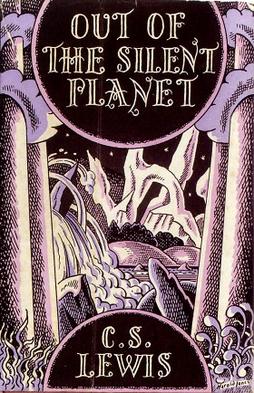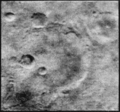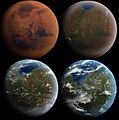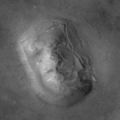Mars in fiction facts for kids
Novels and short stories about Mars have been popular for over a hundred years. The planet's dramatic red color that some people can see is one reason for this. another is that the planet is close to Earth. Also, it looks somewhat like Earth. There are also stories about creatures from Mars on Earth and elsewhere.
Near the end of the 19th century, the astronomer Giovanni Schiaparelli reported seeing what he thought might be water channels on Mars. Because the Italian for channels is canali, English translations tended to render the word as "canals", implying artificial construction. This led to the idea of intelligent beings on Mars before it apparently dried up.
The following works of fiction deal with the planet itself, with any assumed Martian civilization as part of its planetary landscape.
Contents
Novels and short stories
First stories
Several early modern writers, including Athanasius Kircher and Emanuel Swedenborg, hypothesized contact with Mars. Early science fiction about Mars often involved the first voyages to the planet, sometimes as an invasion force, more often for the purposes of exploration.
- Across the Zodiac (1880) by Percy Greg.
- Melbourne and Mars: My Mysterious Life on Two Planets (1889) by Joseph Fraser.
- Unveiling a Parallel (1893) by Alice Ilgenfritz Jones and Ella Merchant.
- Journey to Mars (1894) by Gustavus W. Pope.
- The War of the Worlds (1898) by H. G. Wells. (This was later made into a radio drama in the United States and then into at least one feature film.)
- Edison's Conquest of Mars (1898) by Garrett P. Serviss.
- A Honeymoon in Space (1900), by George Griffith.
- Gullivar of Mars (1905) by Edwin Lester Linden Arnold. (The protagonist's name is taken from Gulliver's Travels.
- Doctor Omega (1906) by Arnould Galopin.
- Le prisonnier de la planète Mars [Vampires of Mars] (1908) and its sequel La guerre des vampires [War of the Vampires] (1909) by Gustave Le Rouge.
- Red Star (1908) by Alexander Bogdanov.
1910s and 1920s
- Le Mystère des XV (1911) by Jean de La Hire.
- A Princess of Mars and another ten Mars stories (1912–1943) by Edgar Rice Burroughs.
- Aelita (1922) by A.N. Tolstoy
- Les Navigateurs de l'Infini (1925) by J.-H. Rosny aîné. Humans travels to Mars in a spaceship named Stellarium, and meets two competing races on the planet.
1930s
- Last and First Men by Olaf Stapledon (1930)
- The Swordsman of Mars and Outlaws of Mars (both 1933) by Otis Adelbert Kline.
- "A Martian Odyssey" (1934), a short story by Stanley G. Weinbaum.
- Out of the Silent Planet, by C. S. Lewis (1938)
1940s
- What Mad Universe (1949) by Fredric Brown
1950s
- The Martian Chronicles (1950) by Ray Bradbury.
- Marooned on Mars (1952) by Lester del Rey.
- No Man Friday (1956) by Rex Gordon.
- A World's Revival (Hebrew: תבל בתחיתה Tevel Be-Thiatah) (1955) by Tzvi Livneh.
- The Outward Urge (1959) by John Wyndham.
Living on Mars
By the 1930s, stories about reaching Mars had become somewhat trite, and the focus shifted to Mars as an alien landscape. In the following stories, human contact and basic exploration had taken place sometime in the past; Mars is a setting rather than a goal.
1930s
- Dweller in the Gulf (1932), The Vaults of Yoh-Vombis (1932) and Vulthoom (1935) by Clark Ashton Smith.
- The Northwest Smith stories (1933–1936) by C. L. Moore.
- Legion of Space Series (1934–1982) by Jack Williamson.
1940s
- The Secret of Sinharat, People of the Talisman and another eleven stories published between 1940 and 1964 by Leigh Brackett.
- "Heredity" (1941), a short story by Isaac Asimov
- Robert A. Heinlein The Green Hills of Earth (1947)
- Robert A. HeinleinRed Planet (1949)
- Robert A. Heinlein The Rolling Stones (1952)
- Robert A. HeinleinPodkayne of Mars (1962)
- Seetee Ship (1949) and Seetee Shock (1950) by Jack Williamson
1950s and early 1960s
- Genesis (story) (1951) by H. Beam Piper (see [1],).
- "Omnilingual" (1957) by H. Beam Piper
- The Sands of Mars (1951) by Arthur C. Clarke
- David Starr, Space Ranger (1952) by Isaac Asimov writing as Paul French.
- The Martian Way (1952) by Isaac Asimov
- "One in Three Hundred" (1954) by J. T. McIntosh
- "The Badge of Infamy" (1957) by Lester Del Rey
- The Sirens of Titan by Kurt Vonnegut (1959)
- Perry Rhodan series (1961- ) (in German)
- "A Rose for Ecclesiastes" (1963) by Roger Zelazny
- Philip K. Dick Martian Time Slip (1964)
- Philip K. Dick The Three Stigmata of Palmer Eldritch (1965)).
- Philip K. Dick Destination Mars (1963)
1960s and later
Beginning in 1965, the Mariner and Viking space probes revealed that the canals were an illusion, and that the Martian environment is extremely hostile to life. By the 1970s, the ideas of canals and ancient civilizations had to be abandoned.
Authors soon began writing stories based on the new Mars (frequently treating it as a desert planet). Most of these works have humans struggling to tame the planet, and some of them refer to terraforming (using technology to transform a planet's environment).
A common theme, particularly among American writers, is that of a Martian colony fighting for independence from Earth. It appeared already in Heinlein's Red Planet and is a major plot element in Greg Bear's Moving Mars and Kim Stanley Robinson's Mars trilogy. It is also part of the plot of the movie Total Recall and the television series Babylon 5. Many video games also use this concept, such as the Red Faction and Zone of the Enders series. A historical rebellion of Mars against Earth is also mentioned in the Star Trek series of novels.
In the decades following Mariner and Apollo, the once-popular subgenre of realistic stories about a first expedition to Mars fell out of fashion, possibly due to the failure of the Apollo Program to continue on to Mars. The early 1990s saw a revival and re-envisioning of realistic novels about Mars expeditions. Early novels in this renaissance were Jack Williamson's novel Beachhead and Ben Bova's novel Mars (both 1992), which envisioned large-scale expeditions to Mars according to the thinking of the 1990s. These were followed by Gregory Benford's The Martian Race (1999), Geoffrey A. Landis's Mars Crossing (2000), and Robert Zubrin's First Landing (2002), which took as their starting points the smaller and more focussed expedition strategies evolved in the late 1990s, mostly building on the concepts of Mars Direct.
Late 1960s and the 1970s
- Larry Niven Known Space stories (1964- )
- Die Erde ist nah: die Marsexpedition (1970), by Ludek Pesek, published in English as The Earth is Near (1973)
- Police Your Planet (1975) by Lester Del Rey
- Birth of Fire (1976) by Jerry Pournelle
- Man Plus (1976) by Frederik Pohl, an astronaut is transformed into a cyborg capable of living on Mars.
- The Far Call by Gordon R. Dickson
1980s
- "Ananke" (1982) by Stanisław Lem (a story in More Tales of Pirx the Pilot)
- Watchmen (1985) by Alan Moore and Dave Gibbons
- The Forge of God (1987) by Greg Bear.
- Desolation Road (1988) by Ian McDonald i
- Draka series (1989-)
- Venus Prime (1989) The third book of the series: Hide & Seek is set on Mars.
1990s
- Terry Bisson Voyage to the Red Planet (1990)
- Kim Stanley Robinson's Mars trilogy (Red Mars, Green Mars, Blue Mars, 1992–1996)
- Kim Stanley Robinson: The Memory of Whiteness (1985).
- Mars (1992), Return to Mars (1999) and Mars Life (2008) by Ben Bova, from the Grand Tour series.
- Moving Mars (1993) by Greg Bear
- Red Dust (1993) by Paul J. McAuley
- Bright Messengers (1995) by Gentry Lee
- Voyage (1996) by Stephen Baxter
- Mars Underground (1997) by William K. Hartmann
- Olympus Mons (1998) by Bud Sparhawk
- Beige Planet Mars (1998) by Lance Parkin and Mark Clapham
- Semper Mars (1998) by Ian Douglas
- "Mars is No Place for Children" (1999) by Mary A. Turzillo
- The Martian Race (1999) by Gregory Benford
- Brian Aldiss and Roger Penrose: White Mars (1999)
21st century
- Mars Crossing (2000) by Geoffrey A. Landis
- "The Great Wall of Mars" (2000) by Alastair Reynolds
- First Landing (2002) by Robert Zubrin
- Mars is the scene of the last of three recent space operas by John Barnes: In the Hall of the Martian King (2003). Barnes also sets one of the two Meme Wars novels on Mars: The Sky So Big and Black (2002).
- "Falling Onto Mars, by Geoffrey A. Landis
- Ilium/Olympus series (2003- ) by Dan Simmons
- Stories by Caitlín R. Kiernan:
- "Bradbury Weather" (2005)
- "Zero Summer" (2007)
- "Excerpt from Memoirs of a Martian Demirep" (2007).
- An Old Fashioned Martian Girl (2004), by Mary A. Turzillo
- New Mobile Report Gundam Wing: Frozen Teardrop (2010-ongoing) by Katsuyuki Sumisawa is a novel continuation of the Gundam Wing anime series taking place primarily on the terraformed Mars.
- The Quantum Thief (2010) by Hannu Rajaniemi
Nostalgic Mars fiction
Several post-Mariner works are homages to the older phase of Mars fiction, circumventing the scientific picture of a dry and lifeless Mars with an unbreathable atmosphere through such science fiction generic staples as positing its future terraforming, or creating alternate history versions of Mars, where Burroughs' Barsoom, Bradbury's Martian Chronicles or The War of the Worlds are literal truth.
- Philip José Farmer's World of Tiers series (1965–1993)
- Some Sword and planet series, such as Michael Moorcock's Kane of Old Mars trilogy (1965) and Lin Carter's Mysteries of Mars (1973–1984) are deliberately anachronistic homages to earlier visions of Mars, particularly Burroughs'.
- Robert A. Heinlein: The Number of the Beast (1980)
- A World Of Difference (1990) by Harry Turtledove
- S. M. Stirling's Lords of Creation series includes In the Courts of the Crimson Kings, involving Mars.
- Larry Niven: Rainbow Mars (1999)
- "Larklight" (2006), a story by Phillip Reeve
Comics
- In the Watchmen comic by Alan Moore and Dave Gibbons Dr. Manhattan character tours Mars and visits Olympus Mons, admiring its features. He takes his girlfriend there, soon after he leaves for another galaxy.
- In the 2000 AD series The V.C.s Olympus Mons' crater is covered by a massive dome to retain an atmosphere as the main settlement on the planet.
- Several stories of the DC Comics character Martian Manhunter take place on Mars, and the Manhunter is a Martian. Most of the Green Martians were wiped out by a plague, although the more ruthless White Martians still exist. Martians were among the most powerful races in the Universe, capable of telepathy, shapeshifting, and flight, though they have an aversion to fire.
- The most recent issue of the webcomic Dr. McNinja features Dracula revealing that he discovered the cure for cancer and hid it on Mars.
- In Wonder Woman Pre-Crisis comics, Mars was the base of the god Mars, (see Ares). Spirits of the dead from various planets were taken to Mars and given new bodies to work. The Duke of Deception is a major villain of that world, operating a Lie Factory and making several attempts to invade Earth.
- In January–February 1950, Superman journeys to Mars to help actor-director Orson Welles smash a plot by the Martian dictator Martler to "blitzkrieg the solar system" and conquer the Earth (S No. 62/1: "Black Magic on Mars!").
- In Tales to Astonish #2 (1959) "My Job: To Catch a Martian", a professor, who discovers an empty alien spacecraft, hires a private investigator to find the occupant when no one else will listen to him.
- In Tales to Astonish #3 (1959) "I Discovered the Men From Mars", a man from the year 1990 discovers a Martian space-craft while patrolling the coast on the lookout for communist spies.
- In the Manga and Anime Sailor Moon, released in 1992, in the silver millennium, Mars was inhabited by the warlike descendants of the Greek god Ares. The character of Rei Hino is a modern descendant of Ares and is Sailor Mars. All her attacks are based on fire. Like the other planets in the modern solar system, Mars is no longer inhabitable.
- In the comic strip, Calvin and Hobbes: Weirdos From Another Planet! by Bill Watterson, Calvin and Hobbes travel to Mars because the Earth is too polluted.
- In Marvel Family #36 Mars is shown to be inhabited by a warlike treacherous race that resemble 1940s military dictators. They join the Invaders from Infinity (see List of Captain Marvel (DC Comics) enemies) in their attempt to destroy the Solar System after being defeated, but are beaten and sent back to Mars while the Invaders are imprisoned and destroyed.
Martians in fiction
The Martian is a favorite character of classical science fiction; he was frequently found away from his home planet, often invading Earth, but sometimes simply a lonely character representing alienness from his surroundings. Martians, other than human beings transplanted to Mars, became rare in fiction after Mariner, except in exercises of deliberate nostalgia – more frequently in some genres, such as comics and animation, than in written literature.
Images for kids
-
H. G. Wells' The War of the Worlds is one of the most influential works of science fiction.
-
Data returned from Mars exploration missions in the 1960s and 1970s, such as this photograph by the Mariner 4 probe, led to stories of life on Mars becoming unfashionable.
-
Some works depict Mars being terraformed to allow human habitation.
-
The purported Martian canals (map by Percival Lowell)








